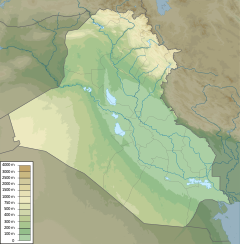| Imam Ali Mosque | |
|---|---|
| Arabic: جَامِع خَطْوَة الْإِمَام عَلِيّ | |
 | |
| Religion | |
| Affiliation | Islam |
| Rite | Shia Islam but sometimes Sunni Islam |
| Ecclesiastical or organisational status | Mosque |
| Status | Active |
| Location | |
| Location | Basra, Iraq |
 | |
| Geographic coordinates | 30°23′59″N 47°44′02″E / 30.3997°N 47.7339°E / 30.3997; 47.7339 |
| Architecture | |
| Type | Islamic architecture |
| Date established | 635 CE |
The Imam Ali Mosque (Arabic: جَامِع خَطْوَة الْإِمَام عَلِيّ) or the Old Mosque of Basra (Arabic: مَسْجِد الْبَصْرَة الْقَدِيم) is the first mosque built in Basra, Iraq and among the oldest mosques in the history of Islam.
History
Establishment and significance
The mosque was founded around 635 during the era of the second Caliph Umar, on the outskirts of Basra right before the conquest of the city. Initially, the building was built from palm canes, but the original building was later burnt down by the great fire. Later the mosque was reconstructed from the mud during the era of the 3rd Umayyad Caliph Umar II. The reconstructed building, however, was destroyed again during the Abbasid era due to the great flood which submerged the city of Basra. After the majority of the Basra citizens evacuated from the old Basra to the newer part of the city, the mosque became a cultural heritage and a site for the pilgrimage to Ali and Aisha. Due to the religious importance of the mosque, the site became a location of many massacres of Arab pilgrims, especially during the Zanj Rebellion. It is considered that the first madrasa for fiqh studies, hadith studies, and philosophy was established within the mosque. Some important figures of early Islamic history were educated here, including Abd Allah ibn Abbas and Wasil ibn Ata. The madrasa was among the first to call the adoption of mind as a way to devise legal problems.
Present day

In 2000, the mosque was restored and rebuilt in its current form. The new construction lacked the connection to the previous architectural style.
In the early 2010s, there were plans to expand the mosque to cover an area of 200 dunums and rebuild it to look like its original form with the addition of six minarets, sixteen doors, and a large courtyard for prayer. However, the plans stalled in 2013 due to the terrible conditions Iraq was suffering through at the time.
In recent years, the mosque witnessed celebrations and gatherings during the days of Ramadan. These include activities like Holy Quran reading competitions and organizing Islamic lectures. Reciters from as far as al-Azhar University from Cairo, Egypt, visit the mosque and its gatherings to participate in commemorating Ramadan nights by reading the Qur’an, as well as commemorating religious occasions. According to Ali al-Baghdadi, who's the man in charge of the mosque, the gatherings include people from all over Iraqi cities, and the Arabian peninsula, in addition to visitors and tourists from Iran, Pakistan, and India. The mosque's significant age role as the first madrasa for fiqh studies, as well as the belief that the mosque was visited by Ali and Aisha after the Battle of the Camel, helped in holding its role as a visitor site.
Architecture
| This section is empty. You can help by adding to it. (October 2023) |
See also
References
- "مسجد خطوة الإمام علي بالبصرة.. ارث إسلامي يتحدى طواغيت العصور]". Al Rsool (in Arabic). Archived from the original on January 5, 2018. Retrieved January 5, 2018.
- "جامع خطوة الامام علي عليه السلام في البصرة يحتاج الى التفاتة من الحكومة". Iraaq 18 (in Arabic). Archived from the original on January 5, 2018. Retrieved January 5, 2018.
- "مسجد خطوة أمير المؤمنين الإمام علي (عليه السلام) - موقع قسم الشؤون الدينية - العتبة العلوية المقدسة". tableegh.imamali.net. Retrieved 2023-10-10.
- ^ "بالصور.. مسجد البصرة القديم مقصد العراقيين في رمضان". www.aljazeera.net (in Arabic). Retrieved 2023-10-10.